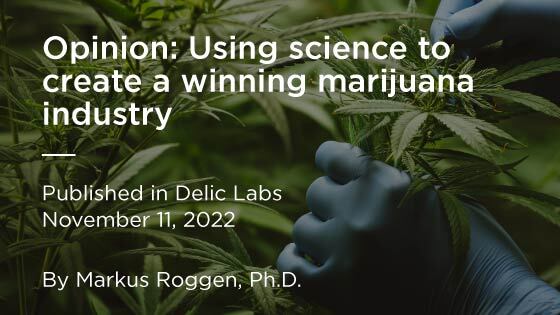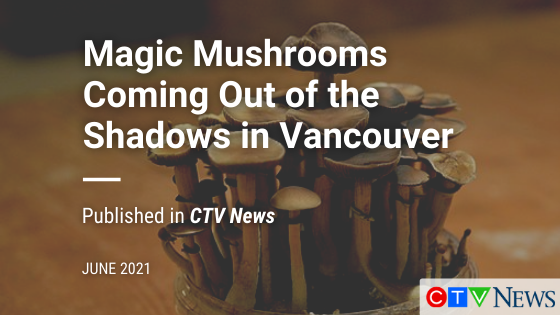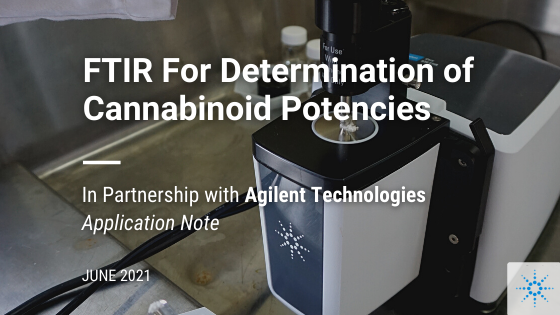Opinion: Using science to create a winning marijuana industry

As we are getting ready to meet with our cannabis industry colleagues at MJBizCon in Las Vegas, I am flicking through the news to see how the industry is feeling. There is great excitement about President Biden pardoning thousands of federal cannabis possession convictions. Even the Canadian Stock market got excited about it. Which makes little sense but is a nice break from the constant news of bankruptcies among Canadian cannabis companies.
Wherever I look, there is only news of doom and gloom. Large mainstream publications started to cover the industry woes across North America. This bombardment of bad news is in oversupply, like cannabis itself. Naturally, the industry is raising the alarm and the cause is easily found. The laws legalizing cannabis across the continent were half backed, contradictory and the government was too greedy with taxation. That means it’s not our fault, right?
Not exactly. I learned a valuable lesson playing sports as a kid. Most of the time it is your fault. So, stop complaining and rise to meet the challenge!,
As I will be discussing cannabis business models at MJBizCon, I wanted to share a few thoughts ahead of time. My perspective is scientific. I hold a PhD in chemistry and am currently the Chief Science Officer of a cannabis CRO, which does not automatically qualify me to be the business voice of reason. But I’ve spent the last eight years helping the industry grow. And most executives of the largest public cannabis companies cannot offer qualifications or results either.
Here are five areas where I think the cannabis industry can improve. It is important not only to identify constraints but also to think of ways that we can restructure around them.
- This is not a legal version of the illegal market.
Cannabis professionals love to complain about long wait times for licensing, restrictive business rules, and even overly picky inspectors, but a legal cannabis market is very different from the illicit drug trade this industry is set up to replace. The death toll from organized crime in Mexico alone between 2006 and 2018 is estimated at 125,000 to 150,000. I for one prefer to pay taxes and wait for licenses instead of being decapitated or dissolved in acid.
Also, a legal market opens opportunities for new processes and products that require time, collaboration, and investments. Arguably, cannabis vapes have had the largest influence on cannabis consumption, and the legal market in California was a prerequisite for those vapes to appear.
- Take a global view of specific problems.
Tax: become hyper-efficient
It seems like complaint #1 by every cannabis business executive is the high tax rate. Paying the tax is hard and even unfair, thanks to 280E in the USA. My argument here is that taxes are just another cost. Another cost that many ignore is the cost of production. We don’t have much power to influence the former, but the latter is squarely within our control. One option is to cut wages or staff numbers, which is a favoured MBA tool. But there are better ways. In our work we have observed that every cannabis producer has inefficiencies. Bad production methods waste hundreds of thousands of dollars every month. This might either be running extraction equipment at 50% capacity or throwing away kilos of THC through.
Testing: not a drag but a weapon
The next most frequent complaint is the burden of compliance testing. Yes, testing costs, but testing also saves. And if we want to save, we should be testing more, not less. Failed batches are also a cost of testing, and they are the main driver of overall testing costs. By doing more Quality Control testing before the cannabis product reaches compliance testing, failures will be caught early, and waste reduced. Better testing protocols would also help. For example, we developed a pooled testing protocol for heavy metal analysis, which could cut test costs by over 50%.
A by-product of all the compliance testing is that cannabis effectively is an organically grown produce, while every year people die from contaminated lettuce. Cannabis is safer than salad! That is a slogan we can proudly proclaim but have yet to use.
More testing is one thing, more tests are another. By expanding the types of tests offered, cannabis products can be marketed in new ways. We already know that THC is not the end-all for product quality. Terpenes are already getting more appreciation, and only testing allows us to print them on labels. It doesn’t stop there, recently volatile sulfur compounds have been found to be responsible for the ‘skunky’ flavor of certain cultivars. And with current tests, we cannot see those. This is a missed marketing opportunity!
- Don’t ask if you could, but if you should.
I see it as misguided to focus on the next/new/revolutionary thing in cannabis marketing, without doing the existing high-volume products right. There are some outrageous products on the market that just make you wonder what were they thinking? CBD mascara and CBD pillows might just sound ridiculous, but products with ∆8-THC have actual potential to be dangerous. Those products solve the problems of producers – namely what to do with all the CBD oversupply and tanked commodity prices. This ignores the needs of the customer. Economic theory teaches us that successful products solve a problem. So, which problems do consumers have? Or at least, which products are they actually buying and would benefit from improvement?
Pre-roll sales total $1.2 billion with a year-over-year growth rate of 39%. And infused pre-rolls, which make up 19% of all pre-rolls sold, have been gaining steadily. The customer clearly wants more pre-rolls and the industry has responded by offering infusion. We should focus our efforts there and develop even better pre-roll product. Our own research has found that pre-rolls deliver about 1 mg of THC per puff, but that number fluctuates based on particle size, joint architecture and smoke position.
- Ask an expert. It will pay off.
The cannabis industry is home to range of professionals and ‘characters’. A simplified timeline of people I met at conferences is that in the mid 2010s there were a lot of legacy growers and civil rights activists. Then slowly the legacy growers either turned to licensed production or retreated from the conferences. Then ‘frontiersmen’ with a taste for exploration and gold rush moved in. These were closely followed by ‘men in suits’ – lawyers and real estate professionals. By 2020, the archetypical cannabis executive is a white maleviiA with a finance or law degree. If these people and qualifications are the right fit for the industry, why is it doing so poorly right now? Even New Cannabis Ventures complained about the situation. A recent newsletter reads: “Cannabis investors, unfortunately, have no shortage of bad companies in which they can invest. […] there are now some great companies trading in our view. Still, there are lots of companies that shouldn’t be trading.”
It’s time to turn to a new crop of experts. We need scientists and engineers to update production, processes and products to fit the 21st-century market.x These are the experts we need now.
- Pick a story and stick with it. And make sure it is the right story.
Cannabis is praised as cure-all to illnesses and economic problems. And the proposed benefits are as numerous and confusing as the stories companies are pitching. Companies often position themselves as pharmaceutical companies, citing potential medical benefits of cannabis. They are not, not even close! And even more perplexing is the fact that some of these same companies also sell recreational products. This is as contradictory as Walgreens selling cigarettes.
How can we expect to develop informed and loyal customers, if cannabis companies, and even the industry as a whole, are jumping from one strategy to the next, constantly changing their values? I see great danger in constantly pointing at the proposed health benefits of cannabis while pushing recreational products.
Here’s a tale of caution that I found in an academic paper:
“In the 15th century, when [it’s] use […] by the indigenous populations in the New World was first observed by Columbus and the plant was brought to Europe, […] this new one was used to treat a wide range of conditions. Indeed, [it] acquired a reputation as a panacea, to the extent of being called the ‘holy herb’ and ‘God’s remedy’.”
The title of this paper: “Medicinal uses of tobacco in history”.
The cannabis industry has great potential, but currently falls short. Instead of complaining, we should self-reflect and improve. In short, stop complaining and start evolving. See you all in Las Vegas.





